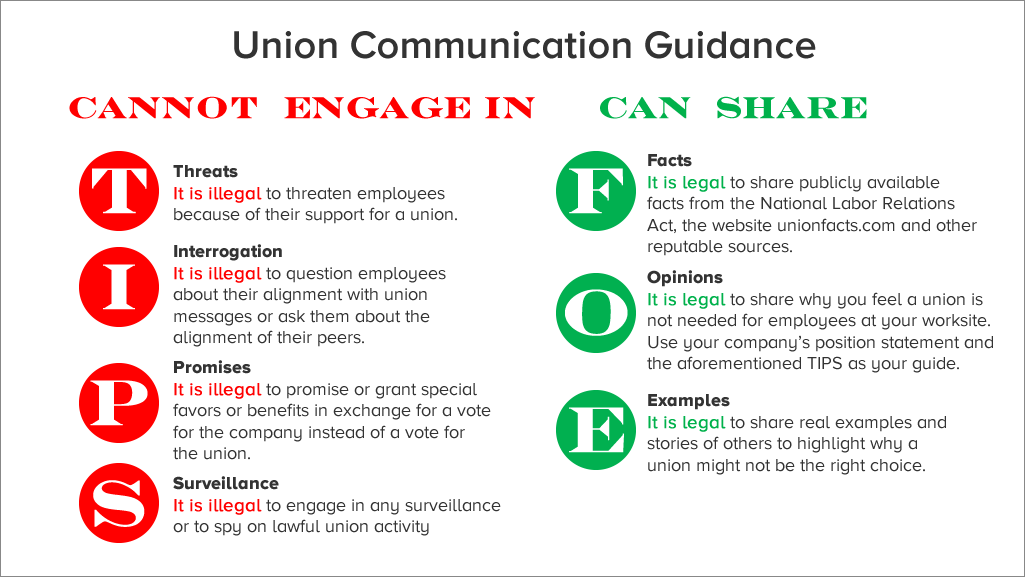During a union-organizing campaign, business leaders will naturally come to HR for guidance. They need a firm understanding of the basic communication expectations.
Before a campaign launches in your workplace, train managers about what they can and cannot say to employees and use role-playing techniques, which will help them get through what may be difficult interactions.

In the moment, leaders are going to want to respond to questions from their employees and must be prepared to educate employees with the relevant facts, to include the company’s position relative to unions. Leaders should be empowered to answer all questions but also need to know the types of things they can and cannot say.
HR professionals can train leaders with the simple “TIPS” and “FOE” rules—acronyms that make it easy for managers to remember. Prior role-playing with HR and having an actual list of company talking points will make it easier for managers to comfortably address questions during a campaign.
TIPS
First, consider what a manager cannot say during a campaign: TIPS.
T = Threats
Threats or coercion are prohibited.
Examples of threats include: telling employees that the company will close a work location or a plant if employees vote for union representation, disciplining an individual or terminating employment because an employee supports the union, or making statements about discontinuing benefits or reducing pay if the union is voted in.
I = Interrogation
It is illegal to ask employees about their support of the union or to ask about the alignment of their peers relative to union support.
Examples of interrogation include: asking employees to give the names of those who attended an organizing meeting, polling employees to see who is a company supporter and who is a union supporter, asking employees if they (or others) have signed an authorization card or how they (or others) will vote, and seeking grievances from employees during the campaign.
P = Promises
A business cannot interfere in the organizing efforts by assuring employees that the company will make things better for them if they just keep the union out. This is just as illegal as making threats.
Examples of promises include: agreeing to address grievances during the campaign, offering pay increases or better benefits, or promising promotions or special treatment to employees for supporting the company instead of the union.
S = Surveillance
Even the appearance of spying should be avoided.
Examples of surveillance include: taking pictures of employees going into a union meeting, telling employees that others have said that they are union supporters, or listening in on employee conversations and taking notes. Management should never attend a union meeting, even if you are invited!
FOE
Keep the following acronym in mind for the kinds of things a manager can say during a campaign: FOE.
F = Facts
Encourage managers to share the facts regarding the union and help set expectations relative to the organizing process.
Examples of facts include: let the employees know about what the company can legally do and what the union can legally do during a campaign and in bargaining, or what to expect relative to how the contract negotiation process takes place if the union should win the election. Share specifics directly from the National Labor Relations Act and from reputable websites. Share words from the union and your own company’s position. Talk about representation statistics (unions represent less than 7 percent of the private-sector workforce today) and bargaining information. Let employees know that if they join a union they will pay dues, which can often add up to the equivalent of several hours of pay—or more—each month.
O = Opinions
Share your own personal beliefs of why you feel a union is bad for the employees, making sure your message is aligned with TIPS and your company’s position.
Examples of opinions include: Let employees know that the decision to be represented by a union is their choice but that in your opinion, you prefer to work directly with employees to resolve concerns. Note that the company has a track record of addressing employee concerns directly and then share an example. Share stories of your own experience or that of someone else who saw firsthand the division between employees and management when the workforce was represented by a union. Say you are concerned that a union could cause a loss of personal communication due to union members having to go through a union steward.
E = Examples
Share specific examples of situations that involve union organizing and contract negotiations.
Examples of situations include: sharing YouTube videos that unions post showing outrageous behavior on the picket line, specifics of promises made during campaigns at other companies versus contracts that unions have negotiated, information about strikes and fines to employees who cross picket lines, and stories about union corruption. Also share examples of positive actions that your worksite has experienced as a result of the employer and employees working directly with each other.
An organization run by AI is not a futuristic concept. Such technology is already a part of many workplaces and will continue to shape the labor market and HR. Here's how employers and employees can successfully manage generative AI and other AI-powered systems.



